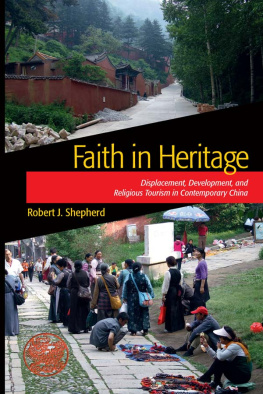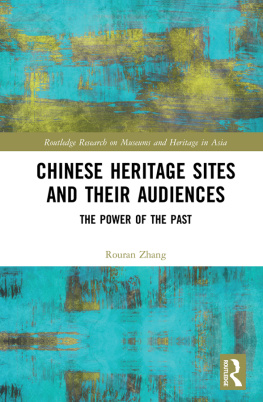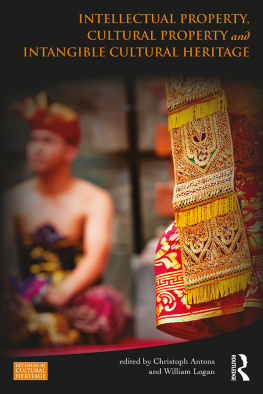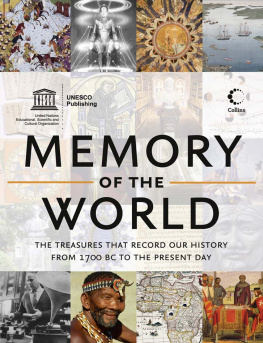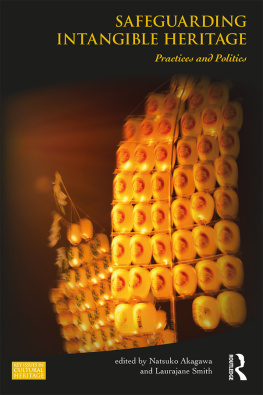First published in 2018 by
Berghahn Books
www.berghahnbooks.com
2018 Haiming Yan
All rights reserved. Except for the quotation of short passages for the purposes of criticism and review, no part of this book may be reproduced in any form or by any means, electronic or mechanical, including photocopying, recording, or any information storage and retrieval system now known or to be invented, without written permission of the publisher.
Library of Congress Cataloging-in-Publication Data
A C.I.P. cataloging record is available from the Library of Congress
British Library Cataloguing in Publication Data
A catalogue record for this book is available from the British Library
ISBN 978-1-78533-804-5 hardback
ISBN 978-1-78533-805-2 ebook
Acknowledgments
Ten years ago, when I was launching the project on World Heritage in China, I never thought that this would be a field full of joyfulness and sadness. Not only is World Heritage a title, but it constitutes the meaning of life for many people. Those who are involved in the identification, nomination, management, and monitoring of World Heritage Sites in China are making sense of their today and tomorrow with the relics left by yesterday. Of course, it is the powerful nation-state and the proactive transnational organizations that created the stories of World Heritage. But it is the people that give meaning and spirit to the stories. Although this book has a critical tone for World Heritage in China, although it shows the collective power of shaping the past, it respects the individuals who dedicated their lives to remembering, researching, and reinterpreting this past.
I am indebted to many people. First and foremost, I am grateful for the critical and encouraging support of Jeffrey Olick. Jeff was enthusiastic about the topic from the very beginning. His inspirational comments on the earlier versions of this manuscript were indispensable for the completion of the work. I also appreciate the valuable help of Krishan Kumar, Sarah Corse, John Shepherd, and Diane Barthel-Bouchier, who helped me develop an interdisciplinary perspective on this booming field of heritage studies and kept offering encouragement for all progress I made. At the early and most challenging stage of this work, I benefited from an ongoing dialogue with my colleagues from the Department of Sociology at the University of VirginiaChristina Simko, Benjamin Snyder, Tara Tober, Licheng Qian, David Hsu, Claire Maiers, Young-Il Kim, Justin Snyder, Fan Mai, and Hexuan Zhangwho provided thoughtful comments for the improvement of this manuscript.
This book would have been impossible without the financial support provided by the Department of Sociology and the East Asia Center at the University of Virginia as well as the Global Heritage Fund. Moreover, I am grateful to the people from the State Administration of Cultural Heritage, International Council on Monuments and Sites China, the United Nations Educational, Scientific and Cultural Organization Beijing Office, the Great Wall Society, and the Beijing Cultural Heritage Protection Center.
Since joining the Chinese Academy of Cultural Heritage, I have had opportunities to work for Chinas World Heritage, firsthand work from which I have benefited tremendously. I would like to thank my intellectual mentorsShuguang Liu, Xiaoming Chai, Yun Zhao, Bing Yu, and Dayan Wenwho have helped me navigate my career transition from a thinker to a thinker and practitioner. My special thanks go to the incredible group of stimulating colleagues from the China World Cultural Heritage Center. Meanwhile, since I served as the Director of Secretariat of International Council on Monuments and Sites China, I have received solid support from Xinchao Song, Yalin Yan, Yang Liu, and the colleagues from the Office of Secretariat.
My appreciation also goes to a number of scholars who have provided incredible help: Luca Zan, Qiong Lu, Shuzhong He, Yi Wang, Florence Bideau, Xiaoping Yu, Xinyu Hu, Jiao Pan, Chu-joe Hsia, Shiding Liu, Jin Li, Guangtian Ha, Min Zhou, Shaozeng Zhang, Chang Liu, Dan Thompson, Kuang-han Li, Qi Liu, Xueting Liu, David Spindler, Daniel Levy, Tiewa Liu, Zheping Xie, and Mia Wu. They were truly supportive in providing guidance, helping me establish administrative and academic networks, helping me locate the archival sources, and providing insightful comments and reflections on World Heritage in China. I also owe thanks to the local residents and officials in Fujian, Dengfeng, and the Badaling section of the Great Wall, who have shown unparalleled hospitality and kindness during my visits. I would particularly like to thank Caryn Berg and Berghahn Books for their excellent and efficient editorial work. I also thank Pat Lucas for his patient help and the reviewers for their encouraging and constructive comments on an earlier version of the book.
This book is dedicated to a lot of people in my personal life, in both China and the United States. I would like to sincerely thank my old friends from ECHO Publishing Company, who are prominent heritage experts: Yongsong Huang, Mi Chen, and the late Meiyun Wu. Moreover, I am extremely grateful to the people who helped me overcome the difficult circumstances I faced during my early years as a Chinese student in the United States. Betsy and Bob Brickhouse, as well as their whole family, deserve special mention for their invaluable hospitality and friendship. The late Steven Nock was an influential mentor for me in graduate school. All my friends at the University of Virginia will be a precious memory that will endure throughout my life.
Finally and most importantly, this book is for my family. The book is my particular memory of my aunt, Jukun Hou, who passed away as I was writing it. She generously opened the world of cultural heritage to me when I was a child and guided me into this colorful world. My parents have been remarkably supportive throughout the progress of the manuscript. They deserve my greatest gratitude. Above all, this book is dedicated to my wife, Wei Li, who has unconditionally supported me in my endeavors. Her gifted sense of aesthetics always made writing about cultural heritage a joyful experience. There are only three World Heritage Sites that meet all six criteria for designation: Mount Taishan, Mogao Caves, and Venice. I am proud that we have visited all three sites.


